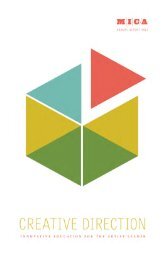art/vision/voice - Maryland Institute College of Art
art/vision/voice - Maryland Institute College of Art
art/vision/voice - Maryland Institute College of Art
Create successful ePaper yourself
Turn your PDF publications into a flip-book with our unique Google optimized e-Paper software.
86 <strong>art</strong> / <strong>vision</strong> / <strong>voice</strong><br />
iii. case narrative<br />
<strong>voice</strong>s:<br />
Elizabeth Ross, ruap Coordinator: a 33-year-old white woman who was<br />
raised in a racially and culturally diverse family, graduate <strong>of</strong> csumb<br />
Johanna Poethig, Pr<strong>of</strong>essor in csumb is Dep<strong>art</strong>ment <strong>of</strong> Visual and Public<br />
<strong>Art</strong>; a nationally known <strong>art</strong>ist whose work in public <strong>art</strong> and socially engaged<br />
media has been widely recognized<br />
Anna Perez Rick, an undergraduate student in the csumb’s digital mural class<br />
Duane Shima, a tech assistant for the digital mural class<br />
Mike Chavez, Counselor and Teacher, Fenix Youth Services, a gangintervention<br />
youth group<br />
Linda Leigh, Administrator for the Santa Cruz County Office <strong>of</strong> Education<br />
in charge <strong>of</strong> Watsonville Community School<br />
When the csumb Digital Media Lab students began their year-long<br />
p<strong>art</strong>nership with Watsonville Community School, Proposition 21,<br />
legislation pending in California, was threatening to further criminalize<br />
youth whose social behavior, dress, or geographical location could be<br />
interpreted as “gang-like.” Many <strong>of</strong> the university students p<strong>art</strong>icipating<br />
in the project were gravely concerned that the Watsonville youth—many<br />
<strong>of</strong> whom had been removed from regular schools for truancy and<br />
behavior problems—would be adversely affected by these new<br />
draconian measures.<br />
The ruap service-learning curriculum that supported the digital<br />
mural class aimed at helping university students understand the issues<br />
<strong>of</strong> class, race, and violence that contributed to conditions <strong>of</strong> risk for the<br />
youth. In trying to get to know their p<strong>art</strong>ners in this project, csumb<br />
students weighed heavily these conditions and began to en<strong>vision</strong> a bus<br />
shelter image that would educate the larger public to the political<br />
realities <strong>of</strong> this social justice issue.<br />
The Watsonville youth p<strong>art</strong>ners met one-on-one with the csumb<br />
students to begin creating preliminary images. Most themes that<br />
emerged from these meetings focused on gangs, incarceration, stopping<br />
the violence, controlling anger, and hopes for education. In the midst<br />
<strong>of</strong> the process <strong>of</strong> designing the image campaign, however, something<br />
began to change, and this change would become the key to achieving<br />
the ruap goal <strong>of</strong> reciprocity in this project.<br />
P<strong>art</strong>icipating youth began regular visits to csumb’s campus to use<br />
the Digital Media Lab, and university students began to visit the youth<br />
at Watsonville. The group continued to pursue their discussions <strong>of</strong> the<br />
issues <strong>of</strong> youth anger and hopelessness. With the help <strong>of</strong> their csumb<br />
p<strong>art</strong>ners, the youth wrote expressions <strong>of</strong> their deep emotions, and the<br />
words tumbled out.
















